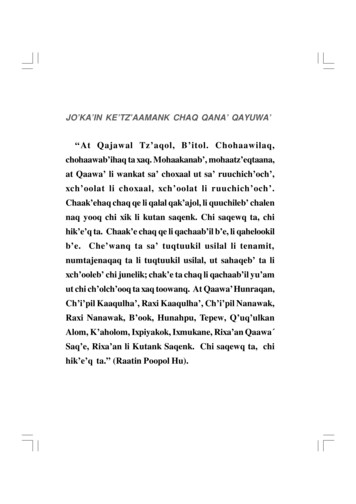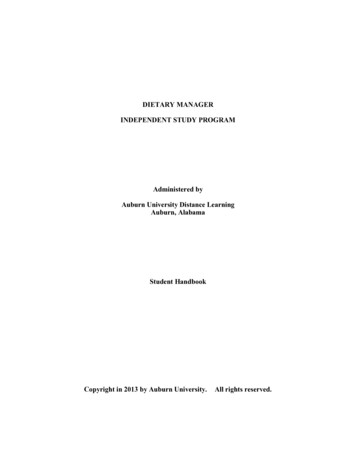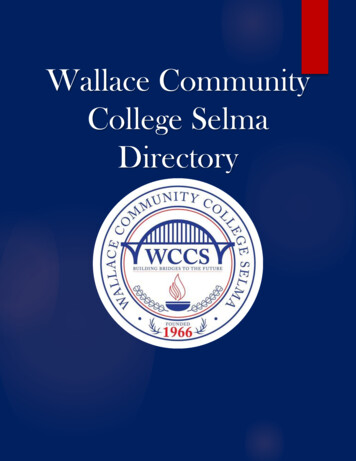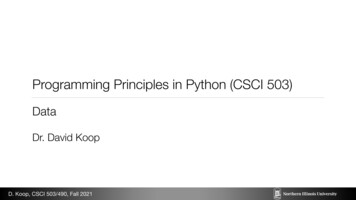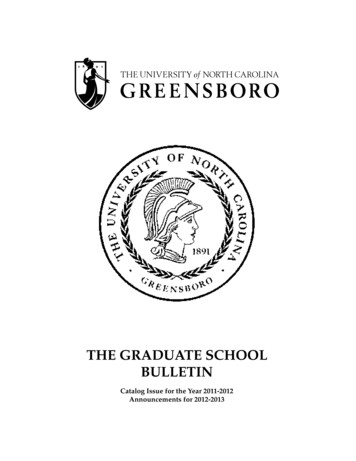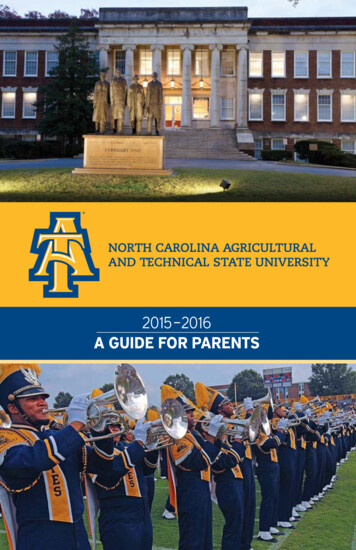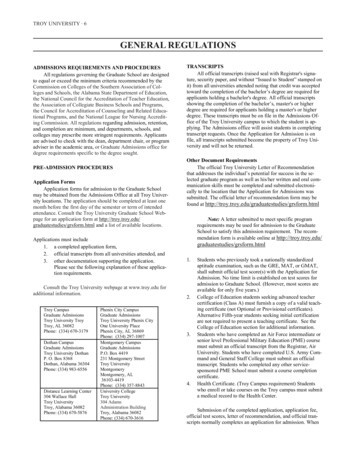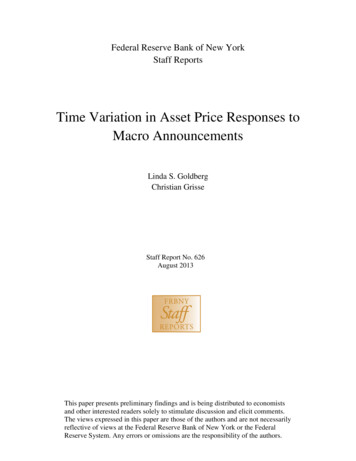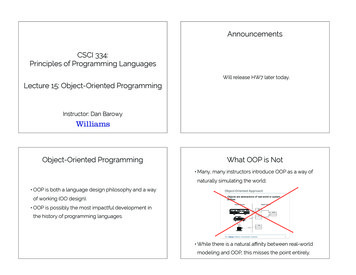
Transcription
AnnouncementsCSCI 334:Principles of Programming LanguagesWill release HW7 later today.Lecture 15: Object-Oriented ProgrammingInstructor: Dan BarowyObject-Oriented ProgrammingWhat OOP is Not Many, many instructors introduce OOP as a way ofnaturally simulating the world. OOP is both a language design philosophy and a wayof working (OO design). OOP is possibly the most impactful development inthe history of programming languages. While there is a natural affinity between real-worldmodeling and OOP, this misses the point entirely.
What OOP is Object-oriented programming is actually about scalability. Scalability in codebase size was the original motivation. But OO philosophy also has had a big effect on theHistory First language recognizable as OO:Simula-67. Developed by Kristen Nygaard and othersat the Norwegian Computing Center.scalability of programming teams. Grew out of frustrations using ALGOL.big teams Original plan was to add an “object” library,inspired by C.A.R. Hoare’s “record classes”. It was eventually realized that objects werea fundamentally different way ofstructuring a program; Simula became itssmall teamssmall programsbig programsHistoryown language.History First mainstream success: Smalltalk Developed by Alan Kay, Dan Ingalls, and Adele Goldberg atXerox PARC and later Apple Computer. Used to implement major components of the groundbreakingXerox Alto computer. Highly influential. E.g., C , Java, Ruby, etc. https://www.youtube.com/watch?v Ao9W93OxQ7U
HistoryHistoryAnd they showed me really three things. But I was soblinded by the first one I didn't even really see the othertwo. One of the things they showed mewas object orienting programmingthey showed me that but I didn't evensee that. The other one they showedme was a networked computersystem they had over a hundred Altocomputers all networked using emailetc., etc. I didn't even see that. I was soblinded by the first thing they showedme which was the graphical user interface within you know ten minutes it was obvious to me that allcomputers would work like this some day.OK, really, what is OO?Abstraction Similar concept to abstraction in the lambda calculus;a way of scoping bindings.Object-oriented programming is composed primarilyof four key language features: More concretely: a way of “encapsulating” or hidingdata.1. Abstraction This data structure is called an object.2. Dynamic dispatch Objects are instantiated from a template called a class.3. Subtyping You are already familiar with this idea from Java.4. Inheritanceclass Circle {private int centerX 0;private int centerY 0;private int radius 1;.}
AbstractionAbstractionclass Circle {private int centerX 0;private int centerY 0;private int radius 1;.}Object subclass: ‘Circle’instanceVariableNames: ‘centerX centerY radius’ Users of this code cannot access field members by In Smalltalk, data stored inside an object (an “instancevariable”) is “private” to that object by default (unlike Java).default.Circle c new : error: centerX has private access in CircleSystem.out.println(c.centerX); 1 errorAbstractionObject subclass: ‘Circle’instanceVariableNames: ‘centerX centerY radius’new x: xvalue y: yvaluecenterX : xvalue.centerY : yvalue.radius : 1. self.c : Circle new. In Smalltalk, there is nothing special about new. It it just amethod.Abstraction Objects collect both data (“instance variable”) andfunctions (“methods”). The pairing of data and methods is specifically designedto aid in the evolution of the software system: objectsencapsulate data, and the allowable operations on thatc : (Circle new) x: 3 y: 4.data are defined by methods.
AbstractionDynamic Dispatch In Smalltalk everything is an object. Every object is also, transitively, a subclass of the baseclass, Object. Dynamic dispatch is how functions are called. Unlike in SML, functions (“methods”) are always tied to an Java broke with this convention for performance reasons. It caused great pain when Java Generics wereintroduced.object (or class). A method is called (“dispatched”) by sending a “message”to the “selector” of an object. Scala, which was heavily influenced by both Java and{messageSmalltalk, reverted to the everything-is-an-object modelc getCenter(Scala’s base class is called Any).objectDynamic Dispatch Dynamic dispatch is an algorithm for finding an object’smethod corresponding to a given selector name.Circle objectCircle classTemplateselectorInheritance Inheritance is a time-saving feature. It adds zero “power” to the language (does not changethe set of programs that one can write). However, it makes code substantially easier to write usMethod dictionarynew code The idea is about reuse of code.Circle subclass: ‘ColoredCircle’instanceVariableNames: ‘centerX centerY radius color’ ColoredCircle will “inherit” the new method from Circle. No need to write method unless it is different.
InheritanceSubtyping Inheritance relies on dynamic dispatch to find missingof the things that Circle can do (and then some).methods.superclass (Circle)ColoredCircle object ColoredCircle is a subtype of Circle because it can do allColoredCircle classTemplate We often create subtypes using the inheritancemechanism. However, subtyping and inheritance are two colorcolorMethod dictionary distinct concepts. Subtyping is about the logical relationship between twotypes. Inheritance is a mechanism for code reuse.Subtyping vs. InheritanceSubtyping vs. Inheritance E.g., imagine you are going to implement a Dequeue, aStack, and a Queue. Stack: add and remove from one end (e.g., “left”). Queue: add from one end (e.g., “left”), remove from other(e.g., “right”). Dequeue: add and remove from either end. Formally:Type A is a subtype of a type B if any context expectingan expression of type B may take any expression of typeA without introducing a type error. Subtyping rule-of-thumb: can you substitute class A forclass B? If so, A : B.c : Circle new.moveCircle c.cc : ColoredCircle new.moveCircle cc. Thus, ColoredCircle : Circle.
Subtyping vs. InheritanceObject-Oriented Extensibility Dan Ingalls developed a test for what qualifies as an In terms of code reuse, it makes perfect sense toimplement a Stack and Queue on top a Dequeue.Dequeue has all the functionality needed.“object-oriented” programming language. The test is about the ability to extend software after it hasalready been designed and written. (Smalltalk allows one to “uninherit” methods from asuperclass) E.g., suppose you have a class for aColoredRectangle. But Stack and Queue are not subtypes of Dequeue! The converse is true! Can you define a new kind of number (e.g., fractions), useyour new numbers to define a new kind of rectangle, askDequeue : StackDequeue : Queuethe system to color the rectangle, and have everythingOO vs Functional TradeoffPolymorphismwork? If so, you have an OO system. Dynamic dispatch allows for a kind of polymorphism. OO offers a different kind of extensibility than functional(or function-oriented) languages. It does not matter whether a method exists because of asuperclass or because it just happens to be there.superclass (Vehicle) Suppose you’re modeling a hospital.Toyota objectOperationPrintPayDoctorNursePrint Doctor Print NursePay DoctorPay NurseOrderlyToyota classTemplatewheelswheelsPrint OrderlycolorcolorPay Orderlydoorsdoors Functional programming makes it easy to add operations. OO programming makes it easy to add data.Method dictionary
PolymorphismObject-Closure Duality Objects are kind of closure: can be simulated using E.g,. both Geese and Toyotas can honk. Goose is not a subtype of Vehicle!activation records that bind over function names. Goose is does not inherit from Vehicle!superclass (Animal)Goose objectGoose class But it is very difficult to implement subtyping andinheritance correctly without first-class support!superclass (Animal)TemplateGoose objectcolorGoose Fea. colorcolorwingLengthnumFeatherswingLen.numFea. Method dictionary honkMethod dictionaryhonk
Principles of Programming Languages Instructor: Dan Barowy Lecture 15: Object-Oriented Programming Announcements Will release HW7 later today. Object-Oriented Programming OOP is both a language design philosophy and a way of working (OO design). OOP is possibly the most impactful development in the history of programming languages. What .
